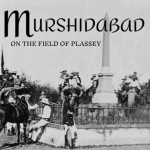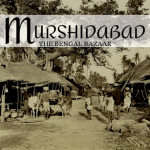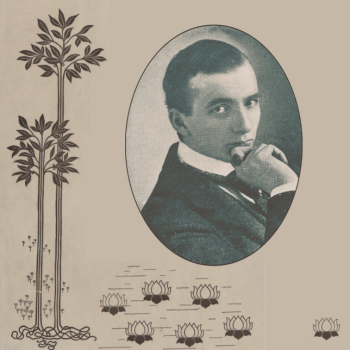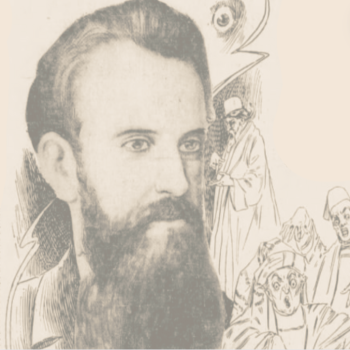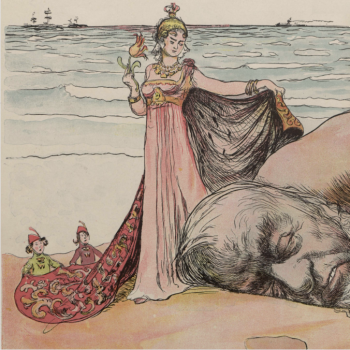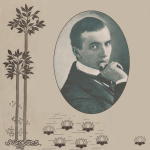AN INDIAN SCHOOL
Charles Johnston.
Early November 1889.
We came back to our tents after a gallop in the cool of the morning, and found the little world of the mango grove wide awake and stirring. The scarlet-capped woodpeckers were already at work among the leafy boughs; now and then a grey squirrel would dart across the sunlit patch of sand before our tent, and a pair of pert minas, or many-hued Indian starlings, hurried hither and thither in the grass, shrilly piping to each other over each newfound ant and golden beetle. Overhead, where the pale hot sky gleamed between the dark leaves, the eagles wove wide circles in the air, the sunlight glinting off their wings, and the long wailing cry of the kites shrilled across the stillness. In the treetops, under the last mantle of glossy leaves, green ring-doves softly croon to each other, one of the never ending melodies of the East.
Camp. (Source: Old Indian Photos)
All at once the minas are silent, peering about in suspicious alarm; then, scolding shrilly, they rise and whirr away past our tent to a deeper shade, the grey squirrels seek safety in an upper branch, and even the busy woodpecker pauses for a moment to peep down into a glade beside us. The cause of this woodland panic was soon disclosed in the appearance of a Bengali village school of Pathshala, headed by a spectacled busybody; an aged pandit, in robes and turban of snowy white, who led his brood of youngsters—a score or so of dusky pupils—out to our shadowed camp, and “solicited our Honors’ catechization” with a view to “grants in aid.” They sat in a row on a clean-swept strip of sand, under the boughs; from the coffee-colored toddler of three or four, gay with flowered muslins, a necklace of coins, and tinseled caps for so great an occasion and, to a pretty lad of nine, the pandit’s joy, who bore himself proudly in a crimson cap and dark blue muslin scarf. Each had his palm-leaf writing strips on his lap, whereon to my deep edification he penned, or rather drew with a pointed reed dipped in ink, the curved Bengali letters, chanting their names the while like a young crow—“Kaw, khaw, gaw, ghaw, ngaw,”
A pretty picture, this group of Indian boys, their dark faces, and gleaming eyes full of earnest expectation; their muslin scarves, red, yellow, and blue, lighting up the green shade of the mango trees.
After eulogizing all his boys in flowing Bengali, the fussy little pundit declared that one of his children of the dusk knew real English words: After vernacular promptings sotto voce, a small hopeful, in green and rose-colored muslin, and with a grave little brown face under a gold-tinseled cap, arose, and with immeasurable, severe dignity piped the words: “Uni-vair-sal-gravy-tation!” and then suddenly collapsed, shutting up like a pocket-knife under the strain of violent mental effort.
The little withered schoolmaster then called another forward with the announcement that he had just mastered “Ka-kha,” the Bengali ABC. The pupil, a namesake of the great Ram Chandra, stepped forward with preternatural gravity, salaamed, and folding his hands behind him, began shrilly at break-neck speed, “Ka-kha-ga-gha,” and then stopped short. Three times he began and three times his memory failed him to his own evident surprise and indignation, till at last the little pandit prompted him and all went well. After Ram Chandra came Gopi-Nath, who had got beyond “ka-kha,” and was learning to write strokes. His accomplishment was evidently for him the main fact of the universe, as he squatted solemnly down before us on a mat, spread a narrow strip of palm-leaf on his knees, and bolt upright with elbows drawn in, made three stiff strokes with a reed-pen, blotted them with his muslin sleeve, and looked up radiant for our plaudits. We praised his calligraphy, patted his little cold cheeks, and presented him with a copper piece, to buy a farthing’s worth of Sandesh, a sticky compound of rice, molasses, and ghee, hardly attractive to us, but altogether delightful in the eyes of Gopi Nath.
As a crowning glory, Ram Lal came forth. As he marched forward proudly, it was evident that he rather looked down on Gopi Nath’s performance, having left strokes behind, and learned to write at least four letters. Taking Gopi’s place on the mat, with knitted brow and infinite pains, he covered the palm leaf with sprawling curves, and then exhausted but beaming, handed his work up for scrutiny. We gladdened his heart by promising to keep it, to show to our friends as proof of his skill. After these junior accomplishments, we skipped a few boys and came to Gopal, who, the pandit explained, could read words of one syllable. Without much persuading Gopal came forward with a well-thumbed volume and started off in high-pitched, nasal tones, a narrative beginning, “Ek din ek jan”—“One day a man;” he plodded manfully forward, only stopping now and then to spell words of more than two letters, till he had dragged us, halting, through our long lines. There we stopped him, content to imagine the fourth adventures of the certain man, and Gopal reluctantly retired, while the fussy, pompous little pundit, beamed with wreathed smiles.
The schoolmaster, after inflicting on us two more readings in shrill, nasal Bengali, solemnly brought forward his prize-boy, the incomparable Saroda Prasad. Saroda, after due salaams, recited to us a moral Bengali tale of virtue, rewarded and meritorious poverty, raised to a high place, that was for him the evident moral; Go thou and do likewise. From this the admirable Saroda turned to other feats; he did wonders in mental arithmetic, and expounded the fifth proposition of Euclid in such fluent Bengali as to convince us that he could have finished quite as well with his eyes shut.[1] After this the prize pupil pointed out on a map England and France, and Siva’s paradise in the Kailash mountains. It was very taking to see these little mites demonstrating Euclid at the blackboard, in a fluent Bengali that left me halting behind; and odd too, until one remembered that the ancestors of these children had discovered not only geometry, but trigonometry, and algebra also; giving this last to the Arabs what time the wily Muslims purloined from India the “Arabic” numerals—really conventionalized initials of the Sanskrit numerals, though foisted by the Arabs as their own on a confiding world.
The little pandit then announced that the performance was at an end, and gathering up our praises, with many salaams, he and his pupils took leave of us, and trooped off chattering noisily to their native village. Then the grey squirrels darted once more across the sunlight; the scarlet-capped woodpecker showered new chips on his green shoulders; and the kites with shrilling cry wove their mazy circles away up in the blue.[2]
← Table Of Contents →
SOURCES:
[1] Johnston, Charles. “Helping To Govern India: Kandi Subdivision.” The Atlantic Monthly. Vol. CIX, No. 2. (February 1912): 265-273.
[2] Johnston, Charles. “An Indian School.” The Providence Journal. (Providence, Rhode Island) October 24, 1891; Johnston, Charles. “Helping To Govern India: Kandi Subdivision.” The Atlantic Monthly. Vol. CIX, No. 2. (February 1912): 265-273.


